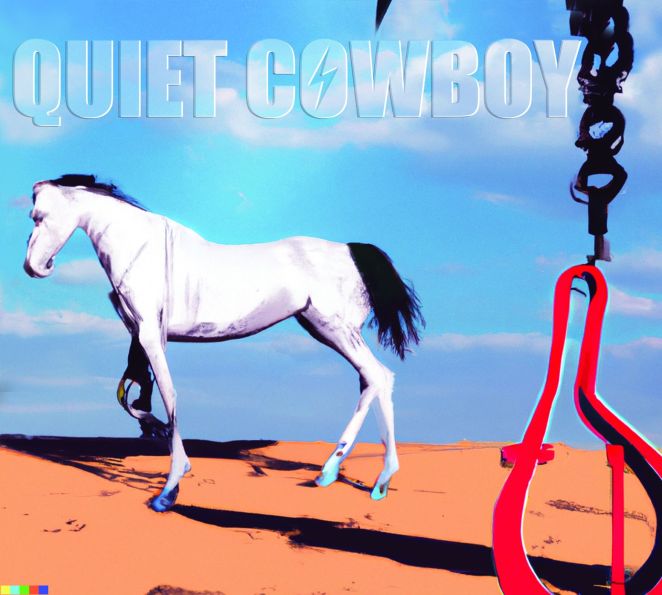Maybe it was the fact that Greek composer Vangelis’ 1982 soundtrack to Blade Runner was playing in the background. The classic composition definitely left its mark, but so did the collection of songs, originally recorded by Michael Chacon, that inspired musician, and songwriter Ron Raymond, the “other half” of the New York-based Quiet Cowboy, to deconstruct and rework his tracks, initially with lyrics, as instrumentals on the duo’s upcoming self-titled album.
Videos by American Songwriter
Even if Raymond—who along with Chacon joined The Sum of All Music, an extensive sound library for Film and TV, during the pandemic—was also taking some cues from late Italian composer Ennio Morricone’s more spaghetti western oeuvres, a la Sergio Leone’s A Fistful of Dollars, that would begin to touch the surface. A multi-instrumentalist, Raymond has played with Chuck Berry, Bo Diddley, and as a guitarist in Jayne County, along with collaborating with Jerry Garcia and co-writing with Ned Douglas (Mick Jagger, Dave Stewart, No Doubt, Katy Perry), among others.
On Quiet Cowboy, Chacon’s songs evolved into a soundtrack of the time, one that began assembling in the middle of the pandemic in 2020. Working between the fall of 2020 through December 2022, Raymond fused mandolin, lap steel guitar, dobro, and more instruments, creating a lush, cinematic landscape of songs throughout the album, along with the lead single “The Space Between,” a slow-roving composition, just one tune on Quiet Cowboy that is sung through a pedal steel guitar.

Recorded in between Raymond’s studio in the Lower East Side of Manhattan and an old rented house in Hudson Valley, New York, Quiet Cowboy captures the noir scenes within a darker space of time, stripping and rearranging the tracks and replacing Chacon’s vocals with the pedal steel.
“Isolation, solitude, and their psychic repercussions are primary themes,” says Raymond of the tracks. “Overall, this is more of a scrapbook of emotional and physic states, rather than descriptive stories.”
Raymond and Chacon spoke to American Songwriter about their reimagined songs, singing through the pedal steel guitar and all that emerged from a “magical woodshed.”
American Songwriter: Quiet Cowboy plays like an exquisite soundtrack. Where does ‘The Space Between” fit within the 11 songs on Quiet Cowboy?
Ron Raymond: I think the soundtrack analogy is apt. Like raw film footage, we had a large amount of songs, which were then deconstructed into a series of tracks and reassembled and edited to become new compositions. As the songs were being finalized, and we started to think about sequencing “The Space Between” seemed to be asking to be heard early on, so it is the first to be revealed.

AS: I know these tracks were based on previous songs that Michael had worked on. What is the specific backstory for “The Space Between”?
Michael Chacon: I would say that Quiet Cowboy tracks are inspired by, rather than based upon some of my previous songs. They are not different versions; they are new compositions. For example, the lyrical content of my previous work does not inform the message that Ron expresses through his lyrically evocative pedal steel. The original song structure and arrangement vanishes through the inspirational process and each is a new creation.
RR: As Michael says these songs were inspired by his previous songs. “The Space Between” was one of the earlier songs to take shape. I loved the acoustic guitar part and looked for a way to repeat that while building dynamically. The piano is the foundation of the second section of the song. My challenge was then how to create a “vocal” arrangement using elements that are unique to the pedal steel guitar.
AS: It’s interesting to discuss songs without actual lyrics for American Songwriter, so as instrumentals, how did the story (stories) between these songs shift as they were reworked?
MC: Ron does not consider any original lyrics. I don’t even send him the lyrics with the musical elements, because we want Ron’s lyrical expressiveness to emerge from the reworking of those elements. There is always going to be original lyrical intent embedded within my musical expression, but that intent becomes nuanced and simply another layer of Quiet Cowboy.

RR: The final product was inspired by and created during a very specific time and place (between the fall of 2020 to December 2022). And the emotional tenor of the songs reflects that. Vangelis’ soundtrack for Blade Runner was always an echo in the atmosphere as I was working. Isolation, solitude, and their psychic repercussions are primary themes. A couple of songs reference specific people (Ethel Cain) or places (Old Kingston Rd.), but overall this is more of a scrapbook of emotional and physical states, rather than descriptive stories.
AS: It seems like there’s a constant shuffle back and forth between the two of you. How do songs typically come together for you both?
MC: As our working relationship has developed, I send individual elements of stripped-down compositions to Ron, and he chooses amongst those elements and rebuilds them into new creations. Ron will send back what he has developed and within a few iterations, we have the foundation.
Ron then goes into his magical woodshed, sings through his pedal steel, and Quiet Cowboy emerges.
RR: That sounds about right.
Photo: Courtesy of Quiet Cowboy / Vicious Kid PR
